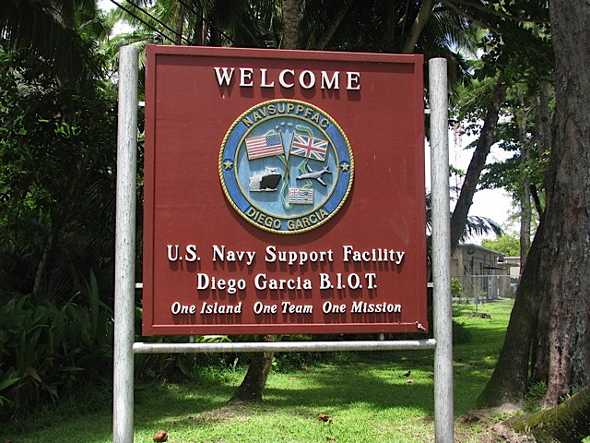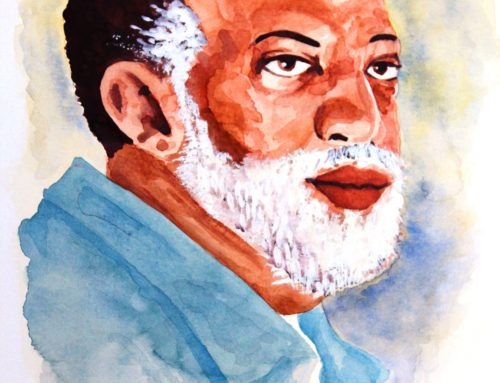by Irtishad Ahmad
“In any case, New Imperialism is already upon us. It’s a remodeled, streamlined version of what we once knew. For the first time in history, a single empire with an arsenal of weapons that could obliterate the world in an afternoon has complete, unipolar, economic and military hegemony. It uses different weapons to break open different markets. Argentina’s the model if you want to be the poster child of new-liberal capitalism, Iraq if you’re the black sheep.”
—– Arundhati Roy, An Ordinary Person’s Guide to Empire.
(And, Diego Garcia – I might add – if you’re a tiny island with a population of a couple of thousands, in a strategically important and geopolitically suitable location.)
It was 1972, Bangladesh just gained independence. Diego Garcia, the name of an island of Chagos Archipelago in the Indian Ocean began to appear in the newspapers. The US government was attempting to establish a military base there. There were some murmurings about this issue in the political circle and in the newspapers of Bangladesh at that time. Why is America coming so close to us to establish a base? What is their motive? Is the US trying to threaten us? As the citizens of a newly independent country Bangladeshis were feeling vulnerable and apprehensive. It was fresh in their minds that just a few months ago, Nixon administration was doing everything possible, including sending its Seventh Fleet to Bay of Bengal, in order to keep Bangladesh from emerging as an independent state.
Well, after a long thirty five years, Diego Garcia faded away from the memory of most Bangladeshis, I am sure. But the US scheme for establishing a military base in this island of Chagos archipelago never stopped. Now it is an island completely controlled by the US Navy. They named the base “Camp Justice” and call the footprint-shaped island “the Footprint of Freedom.” (US Navy)
But after learning what happened to its two thousand or so inhabitants I wondered: Shouldn’t it be called “Camp Injustice” or “the Footprint of Imperialism” instead? But then one should be reminded the US military action in Iraq that began in 2003 was named “Operation Iraqi Freedom.” One may question, freedom of Iraq, or from Iraq? Whose freedom we are talking about? Is there truth in these names? Yes, arguably; only if you flip it. (A friend of mine quipped, “Operation Iraqi Liberation” would have been more meaningful, as it abbreviates to OIL. At least it would have a tint of truth!)
Diego Garcia caught my attention again after so many years when I read Massimo Calabresi’s “Postcard: Diego Garcia” (TIME, Thursday, Sep. 13, 2007).
Calabresi, a TIME correspondent, was accompanying President George W. Bush on his way back from a surprise visit to Iraq in early September of 2007. Air Force One (US President’s special aircraft) landed in Diego Garcia for a 90-minute refueling stop. Let’s hear from Calabresi in his own words,
Welcome to Diego Garcia—6,720 acres (2,720 hectares) of restricted military base on a depopulated atoll in the middle of the Indian Ocean, 1,000 miles (1,600 km) from the nearest continent. Back in 1966, the U.S. signed a secret agreement with Britain allowing the Pentagon to use the territory as an air base in exchange for a big discount on Polaris nuclear missiles. Five years later, hundreds of Navy Seabees arrived by ship and began pouring the 12,000-ft. (3,600 m) runway that would become a bulwark of American cold war strategy and a key launchpad for the first and second Gulf wars and the invasion of Afghanistan. (Massimo Calabresi, “Postcard: Diego Garcia.”)
“Depopulated?” Means what? “Secret agreement with Britain?” What is the reason for secrecy? Read on.
Calabresi continues,
Unfortunately, construction of the base in 1971 crossed the line from efficiency to cruelty. First, the British and Americans had the islanders’ dogs loaded into sealed sheds and gassed, according to Professor David Vine of the American University in Washington. Then the British packed the inhabitants, known as Chagossians, onto ships and sent them off to Mauritius and the Seychelles, 1,200 miles (1,900 km) to the west across the Indian Ocean, where many live to this day.
So, that’s what “depopulated” means! Packing the inhabitants and sending them off somewhere else for good! After a few minutes of surfing in the cyberspace with the keywords “Diego Garcia” a sad saga of the island and its unfortunate inhabitants began to emerge. It was horrifying and depressing.
Diego Garcia is the largest of the fifty-two islands in the Chagos Archipelago in the Indian Ocean. It is only about a thousand miles away from the southern tip of India. Discovered by the Portuguese explorers in the 1500s (and probably named after a Portuguese navigator) Diego Garcia became part of the British Indian Ocean Territory (BIOT) in 1965. Britain leased it to the US in 1970 under a secret deal (kept hidden from the British Parliament or the US Congress).
At that time, about two thousand Chagossians, or Ilois, as they are also called, were living in Diego Garcia. The British government conspired with the US administrations to “sweep” and “sanitize” the island (quoted words were actually used in official US documents).
Let’s hear from John Pilger,
Diego Garcia was first settled in the late 18th century. At least 2,000 people lived there: a gentle Creole nation with thriving villages, a school, a hospital, a church, a prison, a railway, docks, a copra plantation. Watching a film shot by missionaries in the 1960s, I can understand why every Chagos islander I have met calls it paradise; there is a grainy sequence where the islanders’ beloved dogs are swimming in the sheltered, palm-fringed lagoon, catching fish. (John Pilger, “Diego Garcia: Paradise Cleansed.”)
The islanders were fictionalized to be merely transient contract workers and were forced to “return” to Mauritius, one thousand miles away. It did not matter that they were living in the island for at least five generations, it did not matter that they owned their homes, land, agricultural firms, livestock and related businesses in the island.
John Pilger writes on,
What the files also reveal is an imperious attitude of brutality. In August 1966, Sir Paul Gore-Booth, permanent undersecretary at the Foreign Office, wrote: “We must surely be very tough about this. The object of the exercise was to get some rocks that will remain ours. There will be no indigenous population except seagulls.” At the end of this is a handwritten note by D.H. Greenhill, later Baron Greenhill: “Along with the Birds go some Tarzans or Men Fridays …” Under the heading, “Maintaining the fiction,” another official urges his colleagues to reclassify the islanders as “a floating population” and to “make up the rules as we go along.” (John Pilger, “Diego Garcia: Paradise Cleansed.”)
Sir Bruce Greatbatch, the governor of the Seychelles, was given the charge for cleansing Diego Garcia. He began his “sanitizing” operation by gassing almost 1,000 dogs using the exhaust fumes from American military vehicles. “Sanitizing” continued and “the remaining population” were shipped to Seychelles and eventually from there to Mauritius, where they were simply dumped. There a number of them died of depression, heart attack, malnutrition and starvation.
Today Diego Garcia is a critically important refueling base. It has been used during the 1991 Persian Gulf War, and during Operation Desert Fox. It served as a base for B-2 and B-52 bombers to attack Afghanistan, and for long-range cruise missiles aimed at Iraq. In the current “Operation Iraqi Freedom” Diego Garcia has once again played a crucial strategic role. Its bombers, missiles and global positioning antennas can access Asia, Africa and the Middle East.
Now let me tell you briefly how the islanders’ struggle to go back to their homeland is being defeated by the superpowers.
In 2000 England’s highest court ruled that deportation of the islanders was illegal. But the British Foreign Office immediately announced that because of a “treaty” with the US the islanders cannot be returned to Diego Garcia. In 2003, in another high court case the 2000 verdict was overturned and the islanders were denied compensation and their right to return. The US has cited “security” reasons for blocking the islanders’ return and the British Government issued a decree in 2004, prohibiting them from ever returning to Diego Garcia.
In yet another ruling in 2006 from the High Court of London, the islanders’ right to return to other Chagossian islands (such as the Salomon islands and Peros Banhos, which are more than 100 miles from Diego Garcia) was acknowledged and the deportation of the islanders was characterized as “outrageous, unlawful and a breach of accepted moral standards.” The US is again opposing the possible relocation of the islanders citing security reasons. They will only allow military personnel and their employees in the Chagos archipelago. (Borguna Brunner, “Where in the World Is Diego Garcia? A strategic U.K. and U.S. airbase with a dark history.”)
The saga of Diego Garcia is seldom reported in the US media. We only hear that President Bush paid a surprise visit to Iraq from an “unspecified location.” We never question where this unspecified location was, or why should it remain unspecified? The common people in the US or in Britain do not know about the massacre or the forcible deportation that took place in Diego Garcia during the seventies. Why? Professor Noam Chomsky has an explanation. In reply to a question about Diego Garcia he commented,
The United States wanted the island as a military base. It wanted it as part of the great system of intervention aimed at the Gulf energy resources. The main U. S. intervention forces, called the Central Command, have been aimed right at the oil-producing areas for many years. …. Nobody knows about it in the United States. If you do a database search in the press, I doubt if it’s been mentioned twice in the last twenty years! So no one knows. Nobody knows about the dispossessed population or anything that’s happened and therefore there’s no protest. You can’t protest something you do not know about.” (Noam Chomsky, “Chomsky on Chagos.”)
This is how the new imperialism works. Let’s go back to the quote from Arundhati Roy, “It uses different weapons to break open different markets.” If “necessary,” the “empire” for “security” reasons and for the sake of “justice” and “freedom” will forcibly deport the entire population from an island! At other times, the empire may simply use food aid or military aid to keep an effective control on a country or region. Oftentimes, it will have no problem finding corrupt local elites, politicians or military personnel. Sometimes, it may use sugar-coated diplomacy; at other times an iron fist may become necessary. Sometimes, a plane full of humanitarian aid is all that the empire needs to send; at other times, it may need to resort to B-52s. In some countries, WTO, IMF or the World Bank can do the job; in others, the empire may need to deploy NATO, or CIA. (Read interview with Professor Anu Muhammad for his account on how World Bank helped destroy the jute industry in Bangladesh, Shaptahik 2000, Nov. 30, 2007).
If aid, trade, diplomacy, bribery – nothing works, the next option – a little unfortunate but harder – imposing economic sanctions could be tried. If that does not work, bombers are waiting in bases like Diego Garcia. After all, keeping the world under the control of empire is no easy task!







